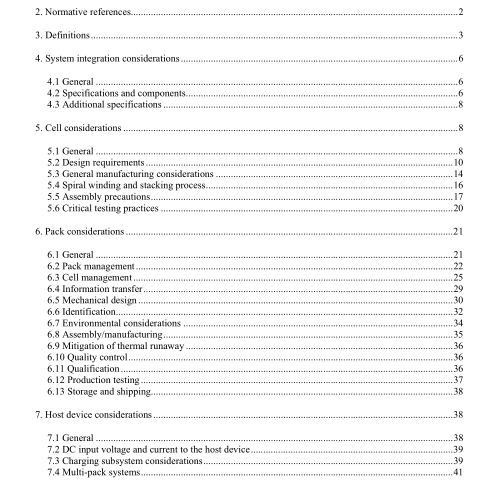IEEE 1625-2008 pdf download.IEEE Standard for Rechargeable Batteries for Multi-Cell Mobile Computing Devices
This standard establishes criteria for design analysis for qualification, quality, and reliability of rechargeable battery systems for multi-cell mobile computing devices. It also provides methods for quantifying the operational performance of these batteries and their associated management and control systems including considerations for end-user notification. This standard covers rechargeable battery systems for mobile computing. The battery technologies covered are limited to Li-ion and Li-ion polymer, but future versions of this standard may include technologies that are not in general use at present. Also included are: battery pack electrical and mechanical construction; system, pack, and cell level charge and discharge controls; and battery status communications. The following are addressed: qualification process; manufacturing process control; energy capacity and demand management; levels of management and control in the battery systems; current and planned lithium-based battery chemistries, packaging technologies, and considerations for end-user notification
2. Normative references
The following referenced documents are indispensable for the application of this document (that is, they must be understood and used, so each referenced document is cited in text and its relationship to this document is explained). For dated references, only the edition cited applies. For undated references, the latest edition of the referenced document (including any amendments or corrigenda) applies.
AIAG SPC-3, Statistical Process Quality Control, Second Edition, 2005. 1
ANSI/ASQ 9002, Quality Management Systems Requirements. 2
IEC 60695-11-10, Fire hazard testing—Part 11-10: Test flames—50 W horizontal and vertical flame test methods. 3
IEC 60950-1:2005, Information technology equipment—Safety—Part 1: General requirements.
IEC 62133:2002, Secondary cells and batteries containing alkaline or other non-acid electrolytes—Safety requirements for portable sealed secondary cells, and for batteries made from them, for use in portable applications.
IEC 62281, Safety of primary and secondary lithium cells and batteries during transport.
IPC-A-610, Acceptability of Electronic Assemblies. 4
IPC-2221, Generic Standard on Printed Board Design.
ISO 9001, Quality management systems—Requirements. 5
UL 94, Standard for Tests for Flammability of Plastic Materials for Parts in Devices and Appliances. 6
UL 1642-2005, Standard for Lithium Batteries.
UL 2054, Standard for Household and Commercial Batteries.
UL 60950-1, Information Technology Equipment—Safety—Part 1: General Requirements.
UN ST/SG/AC.10/11/Rev.4-2003, Recommendations on the Transport of Dangerous Goods—Manual of Tests and Criteria, Fourth Revised Edition.
3. Definitions
For the purpose of this standard, the following terms and definitions apply. The glossary in Annex F and The Authoritative Dictionary of IEEE Standards Terms [B17] should be referenced for terms not defined in this clause. 8
3.1 abuse: Use of product in a way that is not intended by the manufacturer/supplier but which may result from unreasonable or malicious human behavior or unreasonably extreme conditions or environments.
3.2 active authentication: A method of qualification of a battery and/or accessory where the system makes the compatibility decision independent from the end user. For example, the use of a secure memory device within the battery pack that communicates to the host that the pack is suitable for use with a specific OEM’s mobile computing device.
3.3 active charger: A charger that has a communication channel and interacts with the host device.
3.4 adapter: A device that transforms the available power from an external source (for example, ac wall outlet, airline, or automobile outlets, etc.) to the power used by the host.
3.5 aging of cells: Manufacturing process(es) from initial charge to final acceptance.
3.6 authentication: Any method of qualification of a battery and/or accessory designed to ensure compatibility with a specific host device.
3.7 battery/battery pack: An assembly of any number of Li-ion or Li-ion polymer cells, associated electronics, battery packaging, and connector(s).
3.8 battery management circuit: An integrated circuit that manages battery operation to prevent overvoltage, overcurrent, and stops battery operation at set high and low temperatures as well as at a set low-voltage cutoff.
3.9 burr: A sharp metallic projection at the edge of an electrode foil that may penetrate the separator and cause an internal short in a Li-ion or Li-ion polymer cell.IEEE 1625 pdf download.IEEE 1625-2008 pdf download
IEEE 1625-2008 pdf download

Leave a Reply